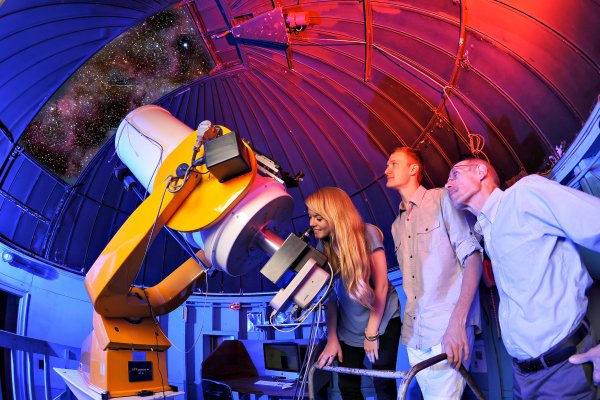Investigating Dying Stars
Bruce Hrivnak, Ph.D.
Professor of Physics and Astronomy
Professor Bruce Hrivnak and his students act as cosmic detectives, using their telescopes to investigate the death of stars thousands of lightyears away.
“All we have are clues about light we receive,” Professor Hrivnak explains. “We can’t go there, yet based on our understanding of light, we can figure out what the stars are made of and how big, how far away, and how bright they are. It really is quite marvelous.”
The dying stars that Professor Hrivnak studies are all in the pre- or proto-planetary nebula stage. After a star uses up all of its hydrogen, it cools and enlarges, becoming a red giant star. The red giant eventually loses its outer layers of gas; as they drift away, the core of the star is revealed, lighting up the gas and causing it to glow as a planetary nebula. The proto-planetary nebula stage covers that middle ground, from when a star loses its outer layer to when it starts to glow.
“It’s a short-lived phase, about 1000 years, compared to the billions of years when a star is fusing hydrogen to helium,” he explains. “If a star’s lifetime were 75 years, this is a 15-minute interval in its life. It’s a very short but important stage.”
For most of human history, the cloud of departing gasses and dust made the proto-planetary nebulae invisible to researchers on Earth. They were only discovered a few decades ago, when infrared satellites detected the stars’ heat. Professor Hrivnak was involved in much of this early research, traveling to telescopes in Ariz., Hawaii, and Chile to measure the stars’ brightness and understand their composition. Eventually, the researchers investigated further using the Hubble Space Telescope.
Because students’ schedules prevent them from traveling around the globe, as Professor Hrivnak did, he designed a research program for students to make meaningful contributions from campus. For years, they have followed about two dozen proto-planetary nebulae, using Valpo’s telescope equipped with a digital camera. Their research has been funded by NASA and the National Science Foundation. On clear nights, student researchers observe and capture images of the stars; on cloudy nights, they use computers to measure the brightness of the photographed stars. Each star’s brightnesses varies with time, and with sophisticated computer programs, the researchers search for periods of that variation.
“Periods relate to the structure of the star and provide us with a probe to understand what’s going on inside the star,” Professor Hrivnak explains. “The light gets brighter and fainter because the stars are pulsating — bigger and smaller, cooler and hotter.”
The periods can be very complicated, and Professor Hrivnak and his collaborators have collected data on some stars for 20 years. Over a 10-week summer research term, students gather enough data to write updated reports about the stars and the observed variation. Their findings influence the research objectives for the next summer’s researchers. Students who conduct a second summer of research have presented their findings at national conferences.
For Professor Hrivnak, the pedagogical benefits are ones that he understands personally.
“I learn best by having hands-on experience. From a textbook, I can learn how to solve certain problems, but the experience of doing research myself is what helped me to understand science and to pursue a career in the field,” he says. “I am glad that we can give those experiences to our students.”
Professor Hrivnak finds that the research experience is valuable for students with a range of career aspirations; it can motivate students to pursue continued research through a Ph.D., or provide future teachers with valuable examples to use in the classroom. In every case, students get to experience the sense of mystery that comes with investigating something new.
“Not everything works out perfectly like a problem in the book,” he says. “The real world is more complicated and more exciting. If it were easy, everyone would want to study astronomy.”
